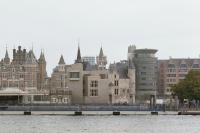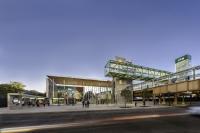Nautical base of Sète
Sète, France
The nautical base takes place in an emblematic site at the end of the St Louis pier in the port of Sète. Of multiple use, it ensures the necessary functionality by regrouping the nautical activities in its base to accommodate on the floor the spaces of offices and conviviality. By its positioning and materiality, the project aims to blend into the landscape while revealing it. It is from the reception room, which opens onto a vast terrace, that the distant horizon is revealed.
It is a space for organizing nautical events, such as regattas, and the reception room is widely open onto a vast terrace that offers an exceptional view of the sea.
The choice of a simple materiality in concrete was established with regard to the proximity with the sea and the stakes of perenniality and minimize the maintenance of the building. It was preferred simple and sober forms.
The building was worked in a will of insertion in the landscape which is revealed since the distant landscape and a close collaboration with the Architect of the Buildings of France was carried out in order to make a success of its intention in particular since the city of Sete and Mount St Clair.
In a will of reflection on materials and short circuit, we worked with a device of reuse of local eco-waste namely the shells of oysters. To do this, a collaboration was undertaken with the company COLAS, which has developed a flooring product made from the use of oyster shells: Colstab Ostréa.
Extract from the Colas presentation document: "Colstab Ostrea was developed by Colas with a view to recovering oyster shell waste from the shellfish industry in the Thau basin.
This waste represents a major challenge for the region, as 10,000 tons of shellfish produced per year generate 8,000 tons of waste. Colstab Ostrea® is a coating made from oyster shell sand and a hydraulic binder, manufactured by the Colas Group, which improves the product's carbon footprint by 50% compared to traditional cement.
With this product, Colas is responding to a local environmental problem and giving new life to shellfish waste.
Thus, outdoor spaces have been treated with this type of flooring, which allows us to demonstrate a desire to build a circular and local economy in this type of project.
- Architects
- NBJ Architectes
- Location
- Môle Saint Louis - Port de Sète, 34200 Sète, France
- Year
- 2023
- Client
- Port de Sète, Région Occitanie
- Team
- Quentin Brion
- Public works company
- COLAS


















